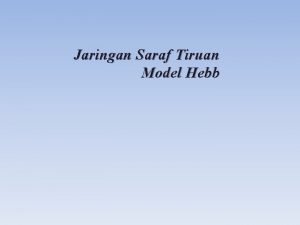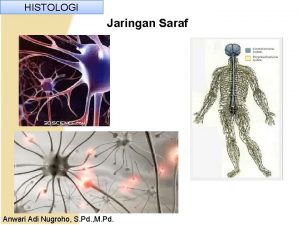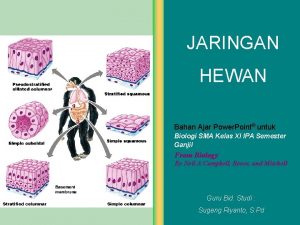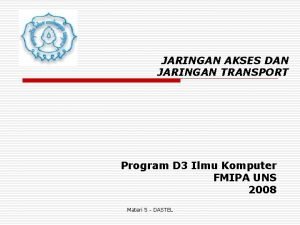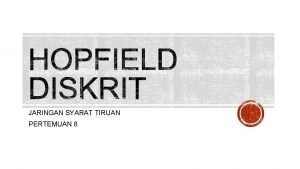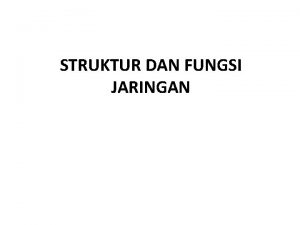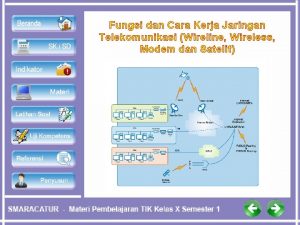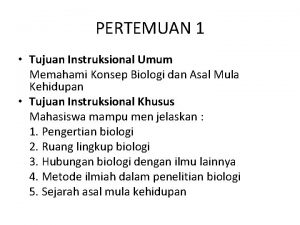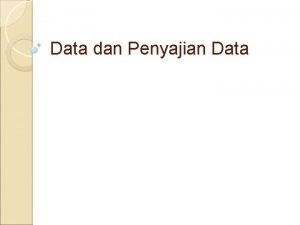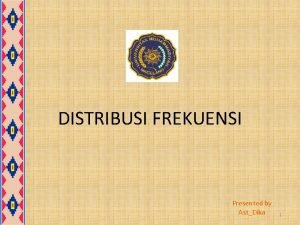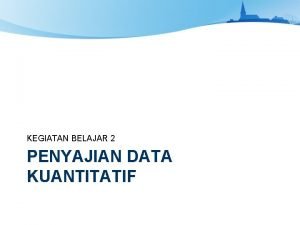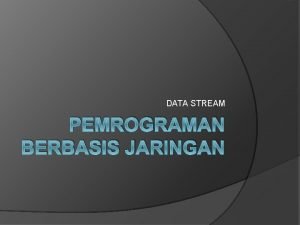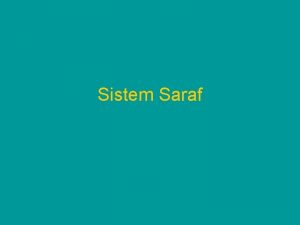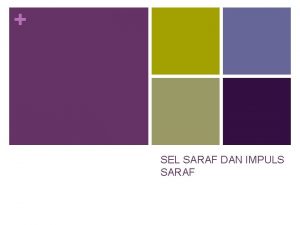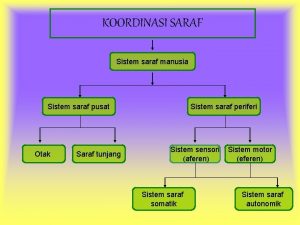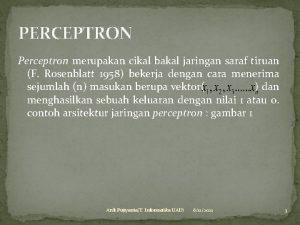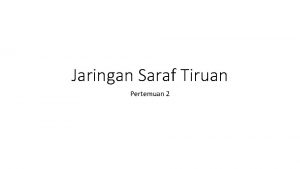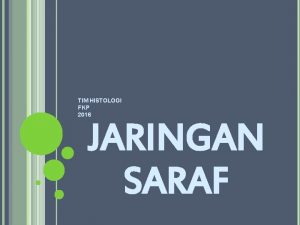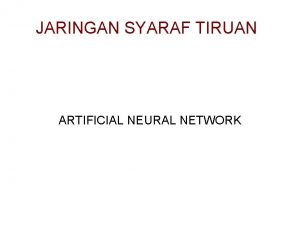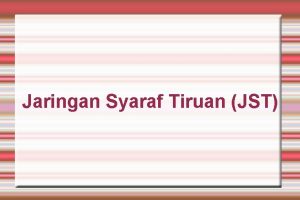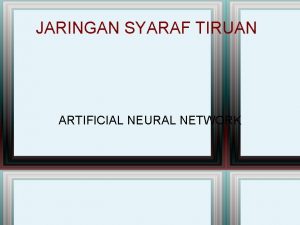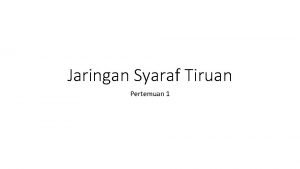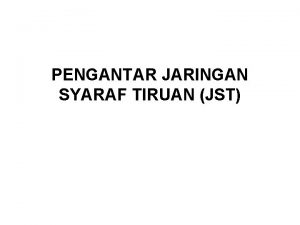Jaringan Saraf Tiruan Jadwal Kelas Selasa Selasa tgl























- Slides: 23

Jaringan Saraf Tiruan

Jadwal • Kelas Selasa : – – Selasa, tgl 18/06/2013 : Ditiadakan (saya ada tugas ke Jatinangor) Senin, tgl 24/06/2013 pkl. 07. 00 - 08. 30 R 4507 : Materi I JST Selasa, tgl 25/06/2013 pkl. 10. 45 - 12. 15 R 4507 : Materi II JST Kamis, tgl 27/06/2013 pkl. 13. 00 - 14. 30 R 4507 : Materi III JST • Kelas Rabu : – Rabu, tgl 19/06/2013 : Materi I JST – Selasa, tgl. 25/06/2013 pkl. 13. 00 - 14. 30 R 4521 : Materi II JST – Rabu, tgl. 26/06/2013 : Materi III JST • Kelas Kamis : – Kamis, tgl 20/06/2013 : Materi I JST – Selasa, tgl. 25/06/2013 pkl. 14. 30 - 16. 00 R 4521 : Materi II JST – Kamis, tgl 27/06/2013 : Materi III JST.

(Artificial) Neural Network • Computational model inspired from neurological model of brain • Human brain computes in different way from digital computer – highly complex, nonlinear, and parallel computing – many times faster than d-computer in • pattern recognition, perception, motor control – has great structure and ability to build up its own rules by experience • dramatic development within 2 years after birth • continues to develop afterward (Language Learning Device before 13 years old) – Plasticity : ability to adapt to its environment

Biological Neuron Excerpted from Artificial Intelligence: Modern Approach by S. Russel and P. Norvig

Models of Neuron • Neuron is information processing unit • A set of synapses or connecting links – characterized by weight or strength • An adder – summing the input signals weighted by synapses – a linear combiner • An activation function – also called squashing function • squash (limits) the output to some finite values

Nonlinear model of a neuron x 1 wk 1 x 2 wk 2 Input signal . . . xm Bias bk Activation function vk wkm Synaptic weights Summing junction (. ) Output yk

Types of Activation Function Oj Oj Oj +1 +1 +1 t ini t Threshold Function Piecewise-linear Function ini Sigmoid Function (differentiable) a is slope parameter

Another representation

Activation Function value range +1 +1 vi vi -1 Hyperbolic tangent Function Signum Function

Signal Flow Graph of a Neuron x 0 = +1 x 2 Wk 0 = bk wk 1 wk 2 . . . xm wkm vk (. ) yk

Neuron with vector input

A Layer Neuron

Multiple Layer Neuron

Example : Fisher's Iris Data • The table above gives Ronald Fisher's measurements of type, petal width (PW), petal length (PL), sepal width (SW), and sepal length (SL) for a sample of 150 irises. The lengths are measured in millimeters. Type 0 is. Setosa; type 1 is Verginica; and type 2 is Versicolor.

NN Clasification in MATLAB >> load fisheriris meas species P=meas; P=P'; T 1=strcmpi(species, 'setosa'); T 2=2*strcmpi(species, 'versicolor'); T 3=3*strcmpi(species, 'virginica'); T=T 1+T 2+T 3; T=T'; net=newff(P, T, 5); net=train(net, P, T); Y=sim(net, P); error=sum(abs(T-round(Y)))

>> xmaxi=net. inputs{1}. process. Settings{3}. xmax 7. 9000 4. 4000 6. 9000 2. 5000 >> xmini=net. inputs{1}. process. Settings{3}. xmin 4. 3000 2. 0000 1. 0000 0. 1000

>> ymaxi=net. inputs{1}. process. Settings{3}. ymaxi = 1 • >> ymini=net. inputs{1}. process. Settings{3}. ymini = -1

>> W 1=net. IW{1} W 1 = 4. 3712 -3. 6262 -1. 9071 -1. 1133 -0. 1448 0. 2100 -1. 0577 0. 1524 -0. 8368 2. 4485 1. 3715 -3. 2401 6. 4131 -7. 4378 -0. 1629 0. 7238 -0. 2555 1. 7087 0. 1774 -1. 5107

b 1=net. b{1} b 1 = -2. 1267 0. 6695 0. 8906 1. 3372 -7. 1393

>> W 2=net. LW{2} W 2 = -0. 5032 -1. 2393 -0. 4487 0. 1026 -0. 0399 >> b 2=net. b{2} b 2 = 0. 1638

>> xmaxo=net. outputs{2}. process. Settings{2}. xmaxo = 3 >> xmino=net. outputs{2}. process. Settings{2}. xmino = 1 >> ymaxo=net. outputs{2}. process. Settings{2}. ymaxo = 1 >> ymino=net. outputs{2}. process. Settings{2}. ymino = -1

Example >> input = P(: , 33) ans = 5. 2000 4. 1000 1. 5000 0. 1000 >> sim(net, input) ans = 1. 0085 >> T(33) ans = 1

sim(net, P(: , 33)) ? ? ? >> p. NN = (ymaxi-ymini)*(input-xmini). /(xmaxi-xmini) + ymini; >> n=W 1*p. NN+b 1; >> a=2. /(1+exp(-2*n))-1; >> y. NN=W 2*a+b 2; >> yfinal = (xmaxo-xmino) * (y. NN-ymino)/(ymaxo-ymino) + xmino yfinal = 1. 0085
 Contoh soal jaringan syaraf tiruan dan penyelesaiannya
Contoh soal jaringan syaraf tiruan dan penyelesaiannya Sabmin
Sabmin Jaa tgl 10
Jaa tgl 10 Jadwal penelitian tindakan kelas
Jadwal penelitian tindakan kelas Saraf
Saraf Download ppt jaringan hewan
Download ppt jaringan hewan Contoh media tiruan
Contoh media tiruan Papan tiruan
Papan tiruan Teori tunika korpus
Teori tunika korpus Jaringan meristem merupakan jaringan
Jaringan meristem merupakan jaringan Jelaskan perbedaan jaringan akses dan jaringan transport
Jelaskan perbedaan jaringan akses dan jaringan transport Jaringan hopfield digunakan untuk tipe jaringan
Jaringan hopfield digunakan untuk tipe jaringan Menurut asal meristemnya jaringan dibedakan atas jaringan
Menurut asal meristemnya jaringan dibedakan atas jaringan Apa itu jaringan wireline ...
Apa itu jaringan wireline ... Jaringan meristem adalah jaringan yang
Jaringan meristem adalah jaringan yang Buatlah peta konsep tentang jaringan tumbuhan
Buatlah peta konsep tentang jaringan tumbuhan Stream adalah
Stream adalah Contoh batas kelas nyata dan semu
Contoh batas kelas nyata dan semu Pengertian distribusi frekuensi relatif
Pengertian distribusi frekuensi relatif Batas kelas nyata dan batas kelas semu
Batas kelas nyata dan batas kelas semu Pengertian distribusi frekuensi
Pengertian distribusi frekuensi Streaming data examples
Streaming data examples Contoh tabel data tunggal
Contoh tabel data tunggal Materi pembelajaran pkn kelas rendah
Materi pembelajaran pkn kelas rendah
